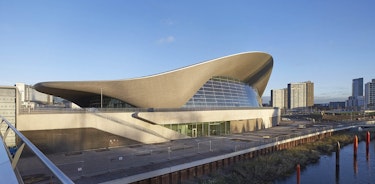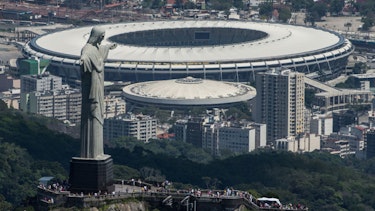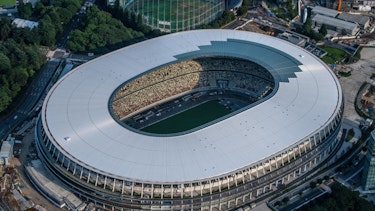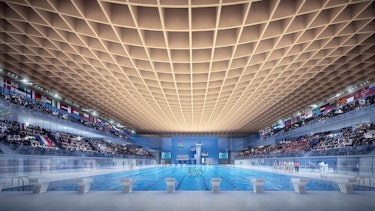As the world prepares for the 2024 Paris Olympics, the excitement surrounding this grand event is not just about the athletic competitions but also about the architectural marvels that will house these events. Olympic structures often stand as enduring symbols of innovation, sustainability, and cultural pride. These buildings do not merely serve functional purposes; they are embodiments of architectural excellence and artistic expression.
With each Olympic Games, new stadiums, arenas, and sports complexes are unveiled, showcasing the host city's unique vision and commitment to excellence. These structures leave a lasting legacy, transforming urban landscapes and becoming landmarks that draw visitors long after the Games have concluded.
As we delve into the world of Olympic architecture, it is fitting to reflect on some of the most iconic Olympic structures of recent times and explore the contributions of creative content studios in making these structures accessible and awe-inspiring to a global audience.
2008 Beijing Olympics - Beijing National Stadium (Bird's Nest)
The Beijing National Stadium, famously known as the Bird's Nest, is one of the most iconic structures built for the Olympic Games. Designed by the renowned architects Herzog & de Meuron in collaboration with the artist Ai Weiwei, this architectural masterpiece hosted the opening and closing ceremonies, athletics events, and football finals during the 2008 Beijing Olympics.
Description:
The Bird's Nest stands out with its intricate lattice structure, resembling a bird's nest, which is both aesthetically stunning and structurally innovative. The design utilizes 42,000 tons of steel and incorporates numerous sustainable features, including a rainwater collection system and a translucent roof that provides natural lighting. The stadium seats 91,000 spectators and has become a symbol of modern China, blending traditional Chinese art with contemporary design.
Architectural Significance:
The Bird's Nest is a testament to China's ambition and capability in architectural innovation. Its design challenges conventional stadium architecture by integrating art and function seamlessly. The collaboration with Ai Weiwei added a layer of cultural depth, making the structure not just a sports venue but a cultural icon.

Credit: Arquitectura Viva
2012 London Olympics - Aquatics Centre
The London Aquatics Centre, designed by the acclaimed architect Zaha Hadid, is another exemplary Olympic structure. This venue hosted swimming, diving, and synchronized swimming events during the 2012 London Olympics.
Description:
Hadid's design is inspired by the fluid geometry of water in motion, featuring a sweeping roof that emulates a wave. The Aquatics Centre can accommodate 17,500 spectators with its temporary wings, which were removed post-Games to leave a legacy facility with a 2,500-seat capacity. The structure incorporates sustainable practices, such as the use of recycled materials and an innovative heating and ventilation system, making it a benchmark for future aquatic sports venues.
Architectural Significance:
The London Aquatics Centre is celebrated for its organic form and integration of sustainable technologies. Hadid's design philosophy of fluidity and dynamism is evident in every aspect of the structure, making it a landmark of modern architecture.

Credit: Zaha Hadid Architects
2016 Rio de Janeiro Olympics - Rio Olympic Arena
The Rio Olympic Arena, also known as the HSBC Arena, was a central venue for the 2016 Rio de Janeiro Olympics, hosting gymnastics and other indoor sports events.
Description:
Designed by the Brazilian architectural firm Índio da Costa AUDT, the arena's design emphasizes flexibility and sustainability. With a seating capacity of 12,000, it features a modular design that allows for reconfiguration for various events post-Olympics. The use of natural ventilation and energy-efficient systems highlights the arena’s commitment to environmental sustainability, aligning with Rio's broader goals for the 2016 Games.
Architectural Significance:
The Rio Olympic Arena stands out for its adaptability and sustainable design. The ability to reconfigure the arena for different purposes ensures its continued use, avoiding the fate of many Olympic structures that become underutilized after the Games.

Credit: Sports Illustrated
2020 Tokyo Olympics - Tokyo National Stadium
The Tokyo National Stadium, also known as the New National Stadium, served as the main venue for the 2020 Tokyo Olympics, hosting the opening and closing ceremonies, as well as athletics events.
Description:
Designed by Kengo Kuma, the stadium integrates traditional Japanese architecture with modern elements. It features a wooden lattice façade made from sustainably sourced timber, reflecting Japan's cultural heritage and commitment to sustainability. The stadium has a seating capacity of 68,000 and includes state-of-the-art facilities and technologies. Its design emphasizes harmony with nature, incorporating extensive greenery and natural ventilation.
Architectural Significance:
Kuma's design for the Tokyo National Stadium is a beautiful fusion of tradition and modernity. It respects Japan's architectural heritage while incorporating the latest in sustainable building practices. This blend makes the stadium a model for future Olympic structures.

Credit: Sky Sports
2024 Paris Olympics - Paris Aquatics Centre
As we look ahead to the 2024 Paris Olympics, the Paris Aquatics Centre is set to be a highlight. Designed by the Danish architectural firm BIG (Bjarke Ingels Group) in collaboration with French architects VenhoevenCS, this venue will host swimming and diving events.
Description:
The design of the Paris Aquatics Centre focuses on sustainability and innovation. It features a wave-like roof covered with solar panels, aiming to generate as much energy as it consumes. The building materials are eco-friendly, and the center incorporates advanced water-saving technologies. With a seating capacity of 5,000, it promises to be a state-of-the-art facility that embodies the Paris 2024 Olympics' commitment to environmental responsibility.
Architectural Significance:
The Paris Aquatics Centre will be a benchmark for sustainable sports architecture. Its design not only aims for energy neutrality but also integrates harmoniously with the surrounding landscape, reflecting a holistic approach to environmental stewardship.

Credit: Rougerie+Tangram
As we celebrate the architectural achievements of recent Olympic Games, it's clear that these structures go beyond their primary function of hosting sports events. They represent a fusion of culture, technology, and sustainability, leaving a lasting legacy for the host cities and inspiring future generations.
As we eagerly anticipate the 2024 Paris Olympics, the architectural feats on display will undoubtedly continue to inspire awe and admiration, showcasing the pinnacle of human creativity and engineering prowess. These structures are not just buildings; they are monuments to human achievement, capturing the spirit of the Olympics and the enduring legacy of excellence in sports architecture.
